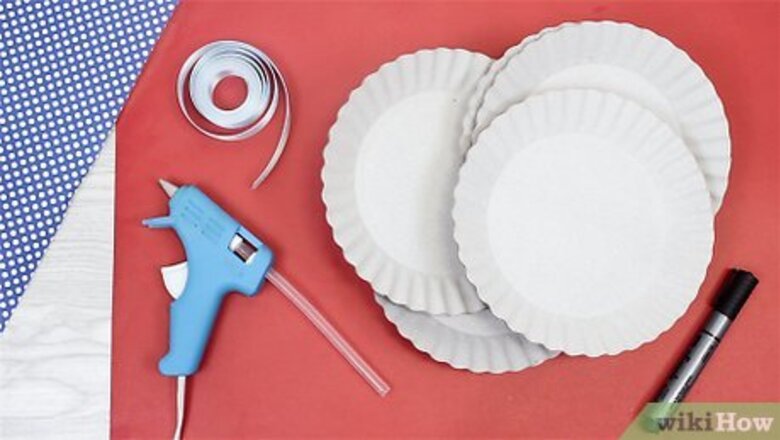
views
Creating Paper Plate Angel Wings

Gather your supplies. The main base of your wings will be composed of paper plates. You'll need a pack of plates or around 20 plates. It's a good idea to have a couple extra plates around in case you make a mistake. You can use whatever color you want. You can also use plastic plates. You'll additionally need: A marker or pencil Scissors Ribbon Glue (Hot glue gun or crafting glue)
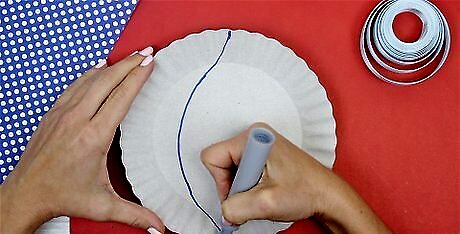
Draw a crescent moon on the paper plates. Starting at the center top edge of your first paper plate, draw a curved line down to the center bottom edge. The separated section should look like a crescent moon and should mostly be the ridged part of the plate. Repeat this drawing on 15 other plates.
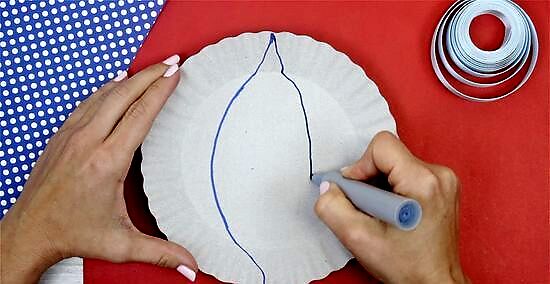
Draw a second crescent moon on each plate. The second crescent moon shape should be the exact mirror of the first. The second crescent moon should have the same beginning and end points. A football or eye shape should remain in between the two separated sections.
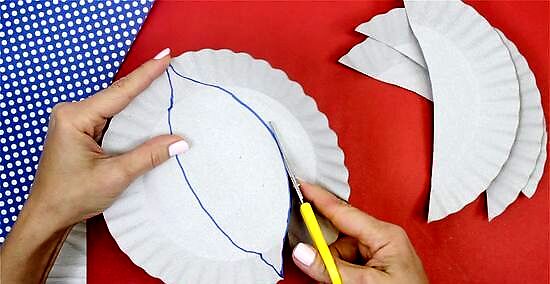
Cut along the lines. Cut out the crescent moon shapes and set them aside. These will be the feathers for you wings. The center section can be discarded.
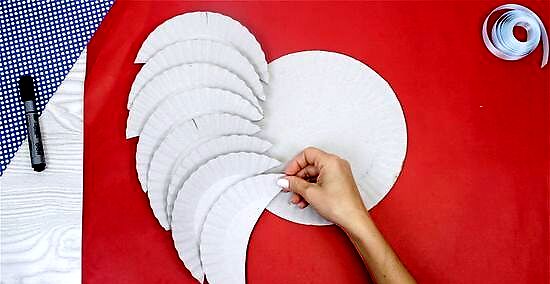
Align the feathers. Line eight of the paper plate feathers along one side of a whole paper plate. You can judge where the feathers should be by looking, but they should be placed close together. The edge of the feathers should all be facing downwards. Look at the whole plate and imagine that it were a clock face with numbers. Starting from the left side, your first feather should be positioned around the 10 or 11 o'clock mark. The plate should be facing up, or the position you'd normally eat from. It helps to position everything before you begin gluing. The angle of the top feather should be aimed outward. The feathers that follow should gradually begin pointing down and in. The lowest feather should end around the 8 o'clock mark.
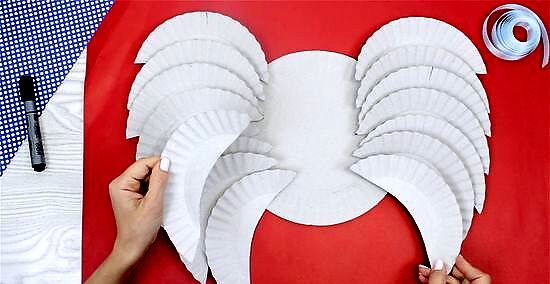
Repeat for the opposite side. Complete the exact process with the remaining feathers. Starting on the right side, the top feather should be around 1 or 2 o'clock mark. The last feather should end around the 4 o'clock mark. Again, the angle of the top feather should be aimed slightly outward. The feathers that follow should gradually begin pointing down and in.

Glue the feathers in place. Once you feel satisfied with how the paper plate feathers look, you can glue them into place. It might be helpful to make small marks with a pen or pencil so that you can remember where the feathers start and end. Apply a dot of glue from a hot glue gun to the tip of each feather where it will be attached to the base. Press each feather to the inside of the whole paper plate. Make all visible glue marks on the inside of the plate.
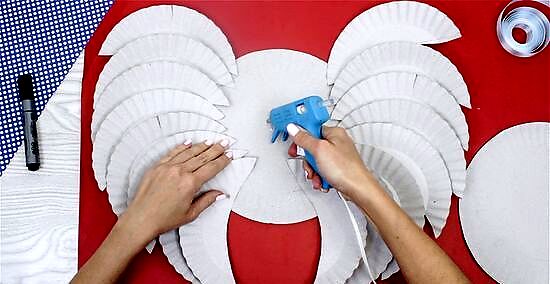
Attach a second plate. Apply a thin line of glue in the center of the paper plate. The glue should be applied to the inside where the attached feather tips are exposed. Press a second plate over the first to secure the feathers.
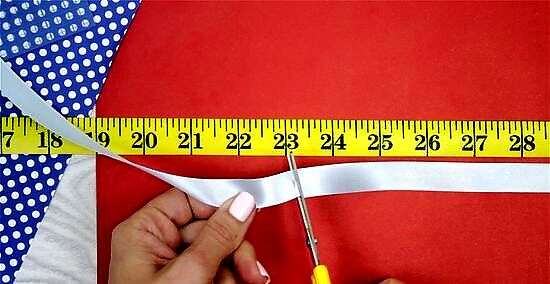
Cut two long pieces of ribbon. Each piece should be around 23 inches (58 cm), or however long they need to be to slip comfortably over the wearer's arms and shoulders. Use a gold ribbon or an ornate ribbon to add to the presentation.
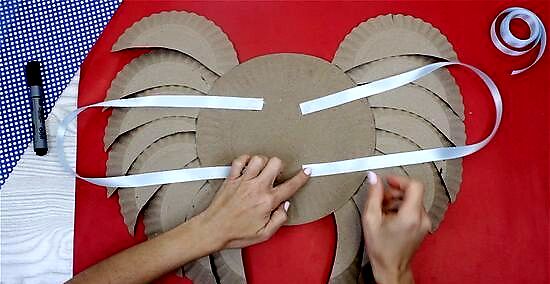
Attach the ribbon to the bottom plate. The top of the ribbon should begin around the same area the feathers begin at. The bottom of the ribbons should end around the same area the feathers end. Apply a small dot of glue on both ends to adhere the ribbons to the plate.
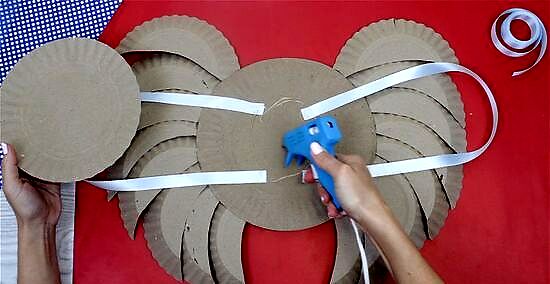
Glue a final plate. To cover the edges of the arm straps and for added security, fix a third plate over the second. Glue around the edges of the second plate and secure the third and final plate over it.
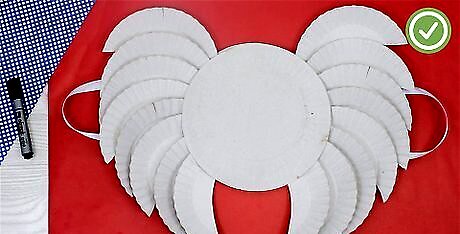
Let the wings dry. Once the glue has finished drying and cooling, the wings will be ready to wear. Wait between 20 to 30 minutes for the glue to dry.
Making Wings With Feathers
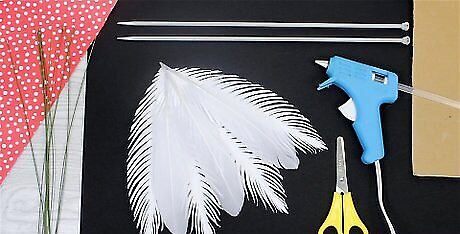
Gather your supplies. Scout thrift stores for used knitting needles. You'll need four to create the frame of the wings. This method will require you to go to a craft supplies store to purchase a bag of feathers and crafting wire (15-20 gauge). You'll also need the following: Spare white t-shirts Hot glue gun Ribbon Spare cardboard Scissors Craft glue
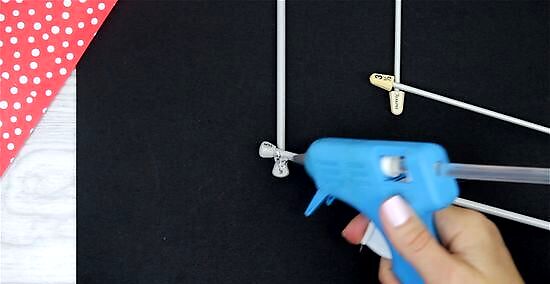
Connect the knitting needles. You'll need to connect two knitting needles together to make one wing's frame. Use a hot glue gun to connect two needles a little wider than 90 degrees. Do this same process to the other pair of knitting needles to create two wings. Allow the glue to dry and settle for about ten minutes before continuing. Make sure the frames are symmetrical before continuing.
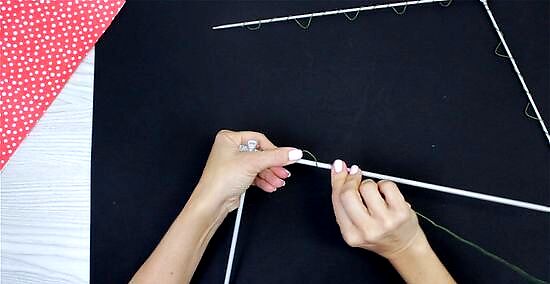
Wrap the frame in wire. Use two strands of wire to wrap around the frame. As you wrap the wire, create small loops on the frame. The loops only need to be about an inch. The wire and loops will be used to attach the cardboard frame. You should use the hot glue gun to attach the wire to the frame. If you're experiencing difficulties attaching the initial wire, begin gluing the wire as you wrap it. The glue and wires will eventually be covered up. There should be roughly eight loops per each needle. This will make about sixteen loops for each wing.
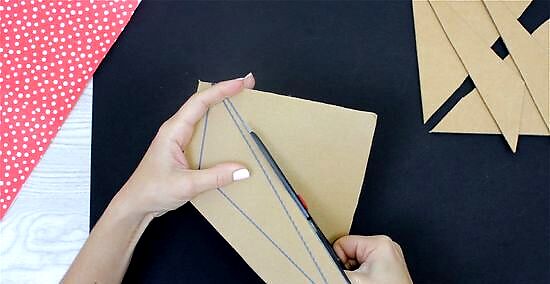
Cut out cardboard pieces. Cut out four triangles for each wing. The triangles don't need to be the same size. It's okay if there are spaces between the needles and the cardboard. The gaps will be covered by the t-shirt and feathers. Try to make your triangles obtuse and isosceles to add to the shape of the wings. Be sure that the four triangles you use for one wing match the four triangles for the other wing.

Attach the cardboard. Lie out the cardboard triangles into a design you like before attaching to the wire. Use spare wire to connect the cardboard triangles to both each other and the knitting needles. They need to be attached, but it's okay if they dangle a bit. Eagle wings are good to base your design on. Look in particular at the eagle wings in the extended-folded position. Another design you can use is to look up angle wings online to see all the variations of angle wings. The cardboard pieces do not have to look perfect or even. They will ultimately be covered up!
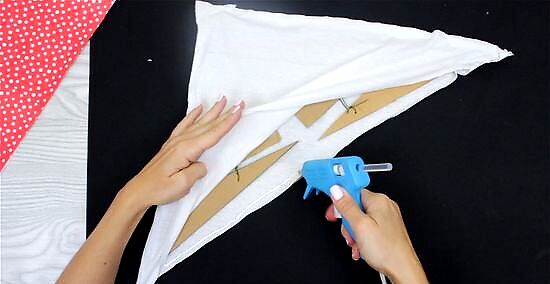
Cover the frame. Use an old, spare t-shirts to create a cover for your frame. Cut off the sleeves of the t-shirt and fit one to each wing. Use the hot glue gun to make sure that your shirt highlights the frame's design. You may need to cut up your t-shirt to create a fitted look.
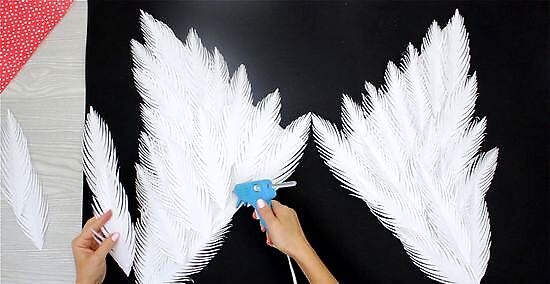
Attach feathers. Use either a hot glue gun or a strong glue stick to attach the feathers to the t-shirt. The key to attaching the feathers is to make sure the feathers are facing outwards. The feathers should also point in the same direction for a clean look.
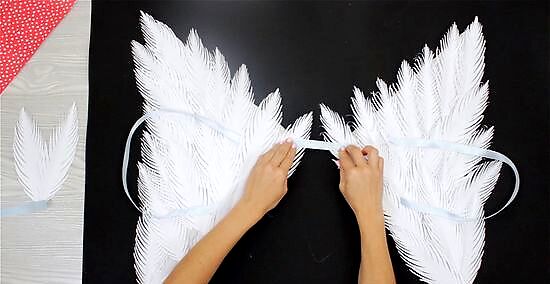
Attach a ribbon. To wear the wings, you need to attach ribbons that fit the wearer's arms and shoulders. Cut a strip of ribbon, about 20 inches. Test the size before attaching to a wing. Once you've found a proper fit, use a hot glue gun to attach the ribbons creating an arm strap. Attach the wings near the top of the wings, close to the wearer's shoulder blades. Repeat the exact process for the opposite wing. You can use a small strand of ribbon to connect the two ribbons together. This will secure the wings to your back and bring them look close together.
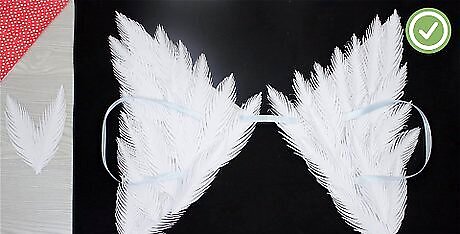
Let the wings dry. Once the glue has finished drying and cooling, the wings will be ready to wear. Wait about 20 to 30 minutes for the glue to dry.
Crafting Coffee Filter Angel Wings
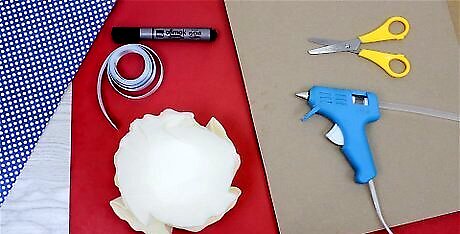
Gather your supplies. The base of your wings will consist of coffee filters and cardboard. Use cheap coffee filters or whatever you have in your home. No need to buy specialty coffee filters for your angel wings. Purchase a full package of coffee filters in case you need additional filters. You'll also need: Scrap cardboard Pen or pencil Scissors Crafting glue Ribbon or shoelaces
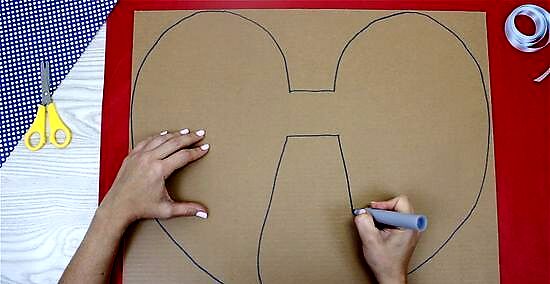
Draw wing shapes on cardboard. The cardboard can be any size you want, but a good size to consider will span the distance between the wearer's chin and lower back. Look at pictures online for inspiration and draw your outline on the cardboard. Make both wings as symmetrical as possible.
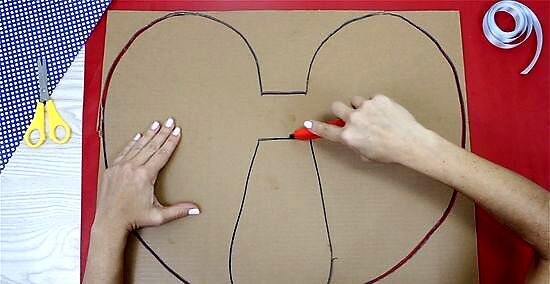
Cut out the wings. Cut along the outline you made with scissors. The cut should be straight and run cleanly from the center dip to the bottom point. This will form the frame of your wings. Spend time creating clean cuts. Ultimately you will cover the edges of the cardboard with coffee filters. Don't restart if you cut an extra line in the cardboard or make a minor mistake.
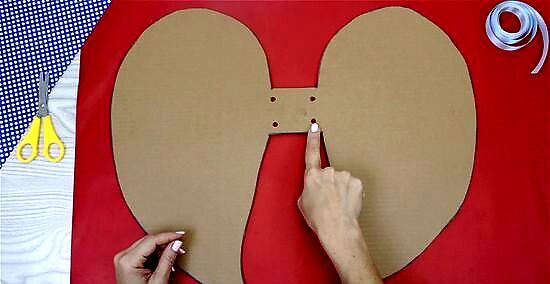
Punch holes into the cardboard for arm bands. You may need to experiment with where the holes should be by holding the wings up to the back of the wearer. One hole should go roughly 2 inches (5 cm) below the top point of one wing. The second should extend down about 4 inches (10 cm) from the first hole created. The other two holes for the second wing should be in the same place.
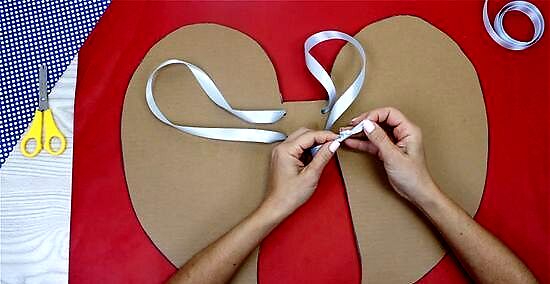
Thread ribbon through the holes. You will need four ribbons, but it's also doable using two. The first ribbon will create an arm strap, securing the ribbon to both holes of one wing. The second ribbon should connect both holes on the other wing and create a second arm strap. Tie the ribbons in place to ensure that there is enough room for the wearer's arm to go through. Two ribbons will secure the wings to your back. The third and fourth ribbons are used to secure the wings together. The third ribbon will connect the top holes of both wings and the final ribbon should connect the bottom holes of both wings. The last two ribbons will be considerably shorter than the arm straps. Tie the ribbons in place to make sure that the wings can be slipped over the wearer's shoulders. Make sure the cardboard can be seen from the wearer's front.

Fold coffee filters in half. The number of coffee filters you need will vary depending on the size of your wings You will need enough to cover the entire front and back with folded filters. Arrange the folded filters onto the cardboard and play with the design until you find a good fit. Experiment by folding multiple coffee into one fold.
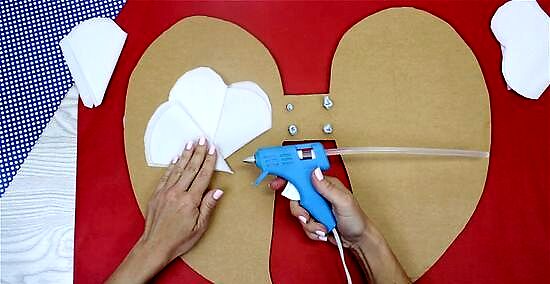
Attach the filters. Glue a line of coffee filters along the inside of each wing. Glue the coffee filters to the front and back of the cardboard. This will make the rounded edges hang over the cardboard on both sides.
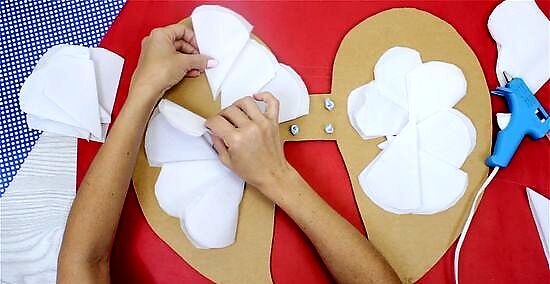
Cover the outer edge of the wings. Starting at the bottom inside corner, slide a coffee filter over the edge of cardboard. Position it in a way that one half covers the front and the other half covers the back. Continue lining the coffee filters along the outer edge of the wing in this manner, overlapping them slightly, until you reach the top inside corner.

Layer coffee filters over both sides of the wings. Each layer should slightly overlap the layer before it. The entire front and back should be covered with halved filters, but do not worry if you can see a little cardboard at the outer edge of the wings.
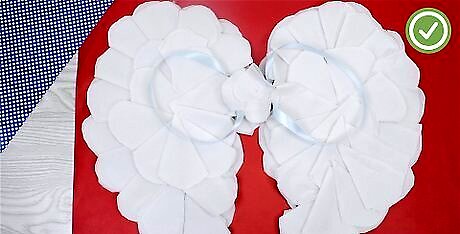
Wait for the glue to dry. Wait about thirty minutes for the glue to dry. Try the wings on once the glue dries. As soon as the glue dries, the wings are ready to wear.











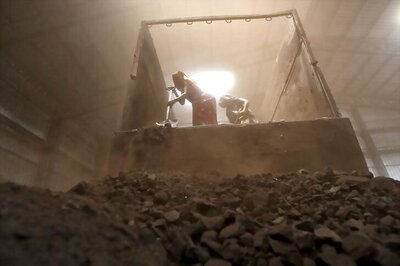
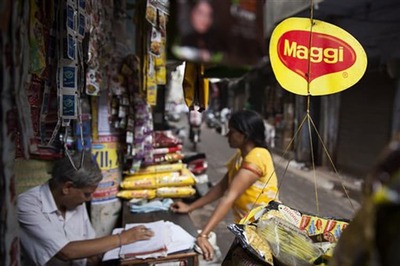





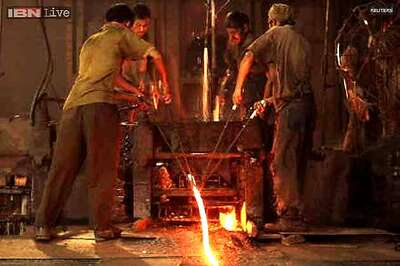

Comments
0 comment